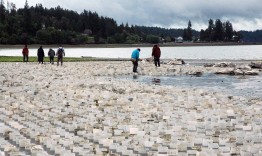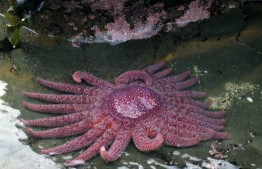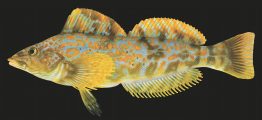The equipment used to farm geoducks, including PVC pipes and nets, might have a greater impact on the Puget Sound food web than the addition of the clams themselves. That’s one of the findings of the first major scientific study to examine the broad, long-term ecosystem effects of geoduck aquaculture in Puget Sound, published last week in the International Council for the Exploration of the Sea’s Journal of Marine Science.
Read more at UW Today »Bubble plumes off Washington, Oregon suggest warmer ocean releases frozen methane
Warming ocean temperatures a third of a mile below the surface, in a dark ocean in areas with little marine life, might attract scant attention. But this is precisely the depth where frozen pockets of methane ‘ice’ transition from a dormant solid to a powerful greenhouse gas. New University of Washington research, whose lead author is UW professor of oceanography H.
Read more at UW Today »Student collaboration leads to first results describing sick sea star immune response
Though millions of sea stars along the West Coast have perished in the past several years from an apparent wasting disease, scientists still don’t know why. The iconic marine creature develops white lesions on its limbs and within days can dissolve or “melt” into a gooey mass. Last year, researchers identified a type of pathogen known as a densovirus as the likely cause, but they still can’t explain the mass die-off three years ago or why a common ocean virus can wreak havoc on so many starfish species from Alaska to Southern California.
Read more at UW Today »Known fish species living in the Salish Sea increases in new report
Coho salmon, Pacific halibut and even the dogfish shark are familiar faces to many people in the Salish Sea region. But what about the Pacific viperfish, northern flashlightfish, dwarf wrymouth or the longsnout prickleback? A new report co-authored by Ted Pietsch at The School of Aquatic and Fishery Sciences documents all fish that live in the Salish Sea, a roughly 6,500-square-mile region that encompasses Puget Sound, the Strait of Juan de Fuca, the Strait of Georgia, the San Juan Islands and the Canadian Gulf Islands.
Read more at UW Today »Young chum salmon may get biggest nutrition boost from Elliott Bay restored beaches
In the midst of ferry boats, container ships and tourists crowding Seattle’s Elliott Bay, young salmon are just trying to get a decent meal. The fish hatch in the rivers and streams that feed into Puget Sound and almost immediately rely on eating small organisms near the shore, including in the heart of Seattle’s commerce-filled waterfront. Though salmon share the busy Elliott Bay waters with boats and barges, scientists suspect built-up, “armored” shorelines and large piers may be the main culprits disrupting fish habitat.
Read more at UW Today »





